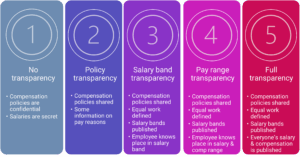Wait, Are You Going to Publish Everyone’s Salaries?
Busting a EU Pay Transparency Myth
Since the EU Pay Transparency Directive came into force, I’ve been hearing nervous questions from employees across dozens of organizations. The concern is almost always the same:
“Does this mean everyone will know exactly what I make?”
Just last week, an employee told me: “The idea of having my salary visible to everyone in the company feels like it crosses a line. That’s really the problem I have with it.”
Another put it this way: “They should be open about salary and compensation – the ranges for each level, bonuses, equity, all of that. But publishing what everyone makes? I don’t see how that helps anyone. There are so many factors that influence someone’s pay. At the end of the day, what I earn should remain private.”
And from a third: “”If the information was anonymous, that would be fine – it would help people understand if they’re being underpaid and do something about it. But compensation is personal. Most people don’t share that information even with close friends or relatives, so why would they want their colleagues to have access to it?”
Here’s the good news: The EU Pay Transparency Directive does not require you to publish individual salaries.
Let me repeat: You do NOT have to disclose what each worker earns.
So where does this misconception come from, and what does the directive actually require? More importantly, how do you navigate the journey to compliance while respecting employee privacy concerns?
The Five Levels of Pay Transparency
Not all transparency is created equal. In fact, there’s a spectrum of transparency approaches, and understanding where your organization sits on that spectrum is crucial for planning your implementation strategy.

What the EU Directive Requires
The EU Pay Transparency Directive requires organizations to achieve Level 4: Pay Range Transparency. This means you need to:
- Share your compensation philosophy and policies
- Define what constitutes equal work
- Publish salary bands for roles
- Ensure employees understand where they sit within their salary and total compensation range
Notice what’s NOT on that list? Publishing individual employee salaries. Level 5 – full transparency where everyone’s individual compensation is publicly available within the organization – goes beyond what the directive requires. Some organizations choose this approach (often startups with strong egalitarian cultures), but it’s not mandated by EU law. This distinction is critical for addressing employee concerns and building trust in your implementation process.
Where Does Your Organization Sit Today?
Before you can chart a path to compliance, you need an honest assessment of your current state. Here’s how to evaluate where you are:
Level 1 indicators:
- Employees are told not to discuss salaries
- Compensation decisions are made behind closed doors without clear criteria
- Pay ranges are known only to HR and hiring managers
- No documentation of compensation philosophy
Level 2 indicators:
- You have a written compensation philosophy, but it’s only shared with managers
- Employees might know some factors that influence pay (e.g., “we pay competitively” or “performance matters”)
- There is no structure employees can reference
Level 3 indicators:
- Job levels are defined and published
- Employees can access salary bands for their current role
- There’s clarity about what it takes to move between bands
- Total compensation (bonuses, equity) remains less transparent
Level 4 indicators:
- Everything from Level 3, plus
- Employees understand their total compensation package
- The range for bonuses and equity is clear
- Employees know where they sit in their full compensation range
Most organizations I work with are sitting somewhere between Level 2 and Level 3, which means they need to make significant changes. But what’s important: you don’t have to jump from Level 2 to Level 4 overnight. You can’t and you shouldn’t.
Why Moving Too Fast Backfires
I’ve seen organizations try to jump from Level 1 to Level 4 in a single announcement. It never goes well. Employees panic about their salaries and privacy. Managers get overwhelmed with questions they can’t answer. HR teams spend months clearing up misunderstandings and firefighting instead of implementing systematically.
The phased approach works because it gives everyone time to adjust. Employees gradually become comfortable with increasing transparency. Managers build confidence through training and early conversations. And you get the chance to course-correct between phases based on feedback and challenges that emerge. Think of it like turning on the lights in a dark room – you don’t want to blast everyone with full brightness immediately. Let their eyes adjust.
The Three Keys to Success
After watching pay transparency implementations, I’ve noticed that successful transitions consistently get three things right:
Manager enablement comes first. Your managers are your front line. They’ll be having the hard conversations about why someone is positioned at the bottom of their band or why a colleague has a different title despite similar work. Before each phase, invest heavily in training. Give them scripts, FAQs, and a clear escalation path. Let them practice with each other. And make training mandatory, not optional.
Communication is constant and repetitive. One announcement isn’t enough. You need to communicate early and often through multiple channels – town halls, intranet updates, manager cascades, email, HR office hours. Repeat the key messages, including privacy protections, until you’re sick of saying them. Your employees are just starting to hear them.
Privacy concerns are addressed proactively. Don’t wait for employees to raise concerns about individual salary disclosure. Lead with it. In every communication, every town hall, every FAQ, reinforce that individual compensation remains confidential. Be clear about what transparency means and what it doesn’t mean. The fear of exposure is one of the biggest barriers to acceptance, so tackle it head-on from day one.
What Happens After Implementation
Achieving Level 4 isn’t a finish line – it’s the starting point for ongoing transparency. You’ll need to maintain regular pay equity audits, update salary bands as markets shift, and create clear processes for employees to request compensation reviews. You must implement systematic approaches for career conversations where managers can discuss growth paths and associated compensation progression. Make transparency part of your new hire experience so it’s not scary or novel, just how your organization operates.
The organizations that do transparency well treat it as a continuous practice, not a compliance project. They regularly survey employees about whether compensation policies is working, adjust their approaches based on feedback, and continuously refine their compensation structures. They’re not afraid to admit when something isn’t working and commit publicly to fixing it.
Privacy and Pay Transparency Can Coexist
The concerns your employees express about pay transparency are valid. Nobody wants their individual salary broadcasted to the entire organization. (Maybe later, when the dust settles, they don’t mind so much anymore.) The good news? That’s not what the EU requires, and it’s not what best practice demands. Level 4 transparency – pay range transparency – strikes the right balance. It gives employees the information they need to understand their compensation and advocate for themselves, while preserving the privacy of individual salary details.
The key to success is taking it step by step. Assess where you are today, build your foundation, and move through the phases deliberately. Communicate constantly, train your managers thoroughly, and address privacy concerns head-on. Your employees don’t need to know what their colleagues make. They need to know that your compensation system is fair, consistent, and applied equitably. That’s what Level 4 transparency delivers. And that’s exactly what the EU Pay Transparency Directive is asking you to achieve.

